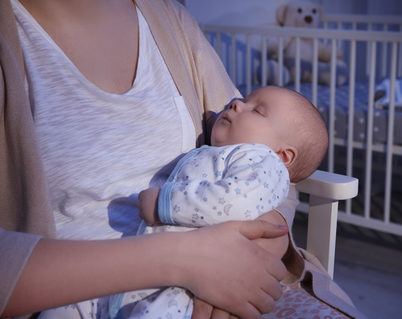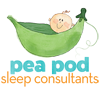 When that first baby arrives, most of us don’t think about sleep associations. During those early weeks, you feed, rock, swing or bounce and your little one will usually fall asleep. You may also be swaddling your baby and turning on that sound machine, too. All those things are sleep associations, and in the beginning they’re great because your baby needs you to be actively involved in the process of falling asleep. By the time babies are a few months old, however, they’re a little more independent and very capable of falling asleep without you being so actively involved.
When that first baby arrives, most of us don’t think about sleep associations. During those early weeks, you feed, rock, swing or bounce and your little one will usually fall asleep. You may also be swaddling your baby and turning on that sound machine, too. All those things are sleep associations, and in the beginning they’re great because your baby needs you to be actively involved in the process of falling asleep. By the time babies are a few months old, however, they’re a little more independent and very capable of falling asleep without you being so actively involved.
What is a Sleep Association?
A sleep association is any action or anything in the environment that helps one fall asleep. Sleep associations can be positive and helpful or they can be negative and unhelpful. Negative sleep associations are commonly known as “sleep props.” Babies cycle through light sleep and deep sleep, and periodically, they’ll wake. If the conditions that were present when they first fell asleep are no longer present when they come to a full waking, they won’t be able to fall back to sleep unless those conditions are re-created. On your part, that’s a lot of middle of the night rocking, swinging and bouncing!
By two to three months of age, it’s important to turn the process of soothing to sleep over to your baby. It’s especially important to set up the conditions in such a way that your baby can fall asleep independently. If babies are placed in their crib while they’re still awake and fully aware of their surroundings, they learn to fall asleep independently. When they acquire the skill of self-soothing, they can get themselves back to sleep if they happen to awaken during the middle of the night. If they don’t acquire this skill, they’ll fuss, cry and continue to need you to help them get back to sleep. You’ll feel needed at first, but night after night, it’s exhausting.
By the time your little one is eight to 12 weeks, it’s important to begin eliminating the actions or things that can’t be sustained all night without you. Those actions or things are the negative or unhelpful sleep associations that you don’t want to be doing while your baby actually falls asleep. (Of course, it’s fine to do all of these things while your baby is awake.) Do keep up the positive associations that can be sustained all night and that your baby can rely on to get back to sleep.
Negative vs. Positive Sleep Associations
| Negative Sleep Associations | Positive Sleep Associations |
| Feeding | White noise |
| Rocking | Dark room |
| Bouncing | Thumb sucking |
| Holding | Moaning, babbling |
| Car seat sleeping | Changing body positions |
| Stroller | Consistent sleeping environment |
| Car rides | Same sleeping surface |
| Swinging | Lovey (ok in the crib after 12 months) |
If your baby is 12 weeks and still relying on the negative or unhelpful sleep associations to fall asleep, it’s time to start turning the process of self-soothing over to your baby. Rely instead on positive associations that can be counted on all night long. There are many ways to help your baby learn to self-soothe. If you’re stuck, we’re happy to help!
